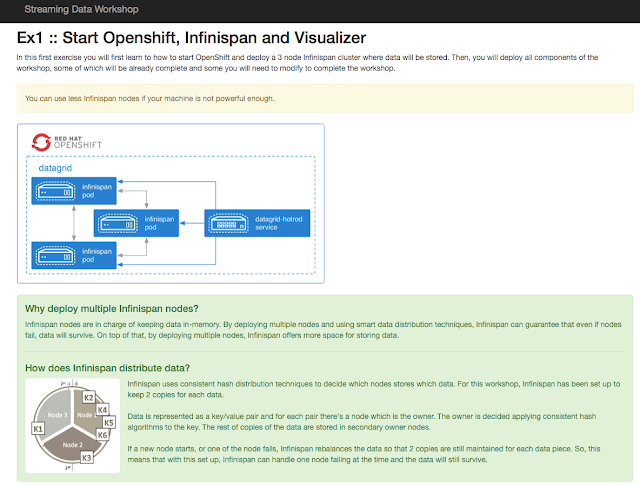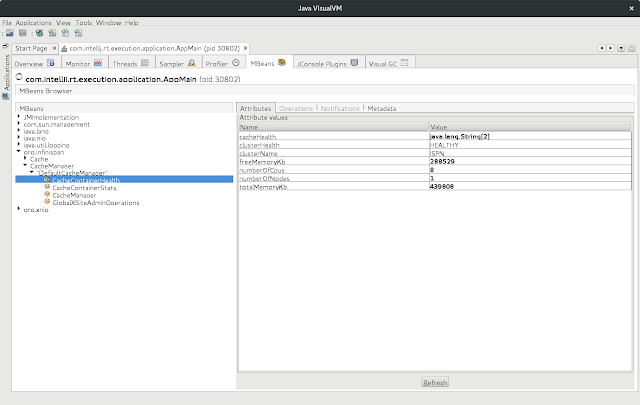Friday, 12 July 2019
Infinispan Operator 0.3.0 expands container and security configuration!
Infinispan Operator 0.3.0 is now available with expanded configuration and security options:
Container Configuration
With this release of the Infinispan Operator, you can configure explicit CPU and memory limits for individual containers. The defaults are 0.5 CPUs and 512Mi of memory.
The Operator also lets you pass extra JVM options, which is useful for tracking native memory consumption or extra GC logging parameters.
Security Configuration
Starting with 0.3.0, credentials are automatically generated for data connector and management users when you instantiate the Infinispan Operator.
The default usernames are developer and admin for the data connector user and management user, respectively.
Generated passwords are stored in Kubernetes Secret instances. You can extract the passwords as follows:
For convenience, the default usernames are also stored in the secret. Using the jq command line tool, you can inspect both the username and password values with a single command:
If you want to set custom credentials for the data connector and management users, create Kubernetes Secret instances as follows:
When using a Credentials type authentication, the referenced secrets must contain username and password fields.
Trying It Out!
The easiest way to get started with the Infinispan Operator is via the simple tutorial. The Operator is compatible with vanilla Kubernetes environments, such as Minikube, as well as Red Hat OpenShift.
Available via Operator Hub
Install the Infinispan Operator directly from the Operator Hub, which is available out of the box on all OpenShift 4 versions. If you’re using a vanilla Kubernertes environment, you might need to install the Operator Lifecycle Manager before you can install via the Operator Hub.
The Infinispan Operator is also included in the community for Kubernetes Operators is available from operatorhub.io.
What’s Next?
The Operator configuration does not yet provide all capabilities available for Infinispan servers. We’re working through a process of configuration specification that distills the server configuration into a simple, easy to use, set of configuration options. The current proposal is being discussed openly here.
Infinispan 10 brings a brand new server that’s no longer based on WildFly. The Operator 0.x series will remain focused on Infinispan 9.x server, with Operator 1.x series focusing on Infinispan 10 and onwards.
Cheers, Galder
Tags: release openshift kubernetes operator
Monday, 08 April 2019
Operator 0.2.1 out with DNS ping and expanded customizations
We’ve just completed the release of the Infinispan Operator version 0.2.1. In this second minor release, we’ve added the following features:
DNS Cluster Discovery
Cluster nodes now discover each other using DNS ping, which uses name lookups. Each node publishes a headless service which they use to locate each other. Previously, Kubernetes APIs were queried to discover other nodes, but this required administrator rights. DNS ping does not require admin permissions.
Tags: release openshift operator beta release
Monday, 04 March 2019
First OpenShift Operator pre-release for Infinispan is here!
Infinispan Operator is a new method of packaging, deploying and managing Infinispan clusters on OpenShift. You can think of the Infinispan Operator as the runtime that manages Infinispan clusters on OpenShift.
We’ve just done our first Infinispan Operator pre-release, version 0.1.0, which allows you to easily boot up an Infinispan cluster on OpenShift.
Using the operator is as simple as installing the Infinispan Operator (requires admin access) on OpenShift, and then create a YAML descriptor that defines the Infinispan cluster. The example below shows how to create a 3-node Infinispan cluster:
And then call:
$ oc apply -f example-infinispan.yaml
A more detailed tutorial on using the Infinispan Operator can be found here. We highly recommend you give it a go and let us know what you think.
Over the next few versions we’ll be adding more features that make the most of the capabilities the Operator framework offers to automatically manage the health and status of running Infinispan clusters.
Please also note that as we work towards the 1.0 release, some things might change :)
Cheers Galder
Tags: release openshift operator beta
Tuesday, 28 November 2017
Back from Madrid JUG and Codemotion Madrid!!
We’ve just come back from our trip to Spain and first of all, we’d like to thank everyone who attended our talks and workshops at Madrid Java User Group and Codemotion Madrid as well organisers and sponsors who made it possible!
We had a very hectic schedule, which started with a Red Hat double bill for Madrid JUG. Thomas Segismont started the evening with Vert.x talk and Galder followed up with a talk on how to do data analytics using Infinispan-based data grids.
In the data analytics talk, Galder focused on how to use distributed Java Streams to do analytics and also showed how to use Infinispan Spark connector when Java Streams are not enough. The distributed Java Streams demo he ran can be found here. The most relevant files of that demo are:
-
Live coding instructions, follow them to do the same steps he did in the talk.
-
Server task solution class using distributed Java Streams.
Galder also demonstrated how to use Infinispan Spark connector by showing the Twitter example. The slides from this talk (in Spanish) can be found here:
Next day on Friday, Galder gave a talk at Codemotion Madrid on working with streaming data with Infinispan, Vert.x and OpenShift. For the first time he was running it all on top of Google Cloud, so he could finally free up my laptop from running the demos and take advantage of the power of a cloud provider!
The demo can be found here where you can also find instructions on how to run it on top of Google Cloud. If you want to follow the same steps he followed during the talk, live coding instructions are here. The slides from this talk (in Spanish) can be found here:
Finally on Saturday we delivered the Streaming Data workshop at Codemotion Madrid. Once again, basing our workshop on top of Virtual Box still caused us some issues, but people managed to get through it. We have some plans for next year to avoid the need of Virtual Box, stay tuned!
 http://3.bp.blogspot.com/-vhDHZjc2CX0/Wh0t4gzxt3I/AAAAAAAAFDY/J_1l7ze26-gYTcp3XSu_S7AeZs2zFbM4QCK4BGAYYCw/s1600/DPfG2yYX0AAH682.jpeg[
http://3.bp.blogspot.com/-vhDHZjc2CX0/Wh0t4gzxt3I/AAAAAAAAFDY/J_1l7ze26-gYTcp3XSu_S7AeZs2zFbM4QCK4BGAYYCw/s1600/DPfG2yYX0AAH682.jpeg[ ]
]
 http://3.bp.blogspot.com/-hKcqGpbsNno/Wh0t4QnaYaI/AAAAAAAAFDI/k8OvIG8-VpMvZPhHRKVjyADMBdASgnBEQCK4BGAYYCw/s1600/DPfG2yWXUAEOdoY.jpg[
http://3.bp.blogspot.com/-hKcqGpbsNno/Wh0t4QnaYaI/AAAAAAAAFDI/k8OvIG8-VpMvZPhHRKVjyADMBdASgnBEQCK4BGAYYCw/s1600/DPfG2yWXUAEOdoY.jpg[ ]
]
We have added more detailed instructions on how to run the workshop in your office or at home, so if you’re interested in going through it, make sure you check these steps and let us know how they work for you:
This trip to Madrid wraps up a very intense year in terms of promoting Infinispan! Next month we’ll be doing a recap of the talks, videos…etc so that you can catch up with them in case you missed any of them :)
Katia & Galder Un saludo!
Tags: conference openshift spark google
Monday, 20 March 2017
Memory and CPU constraints inside a Docker Container
In one of the previous blog posts we wrote about different configuration options for our Docker image. Now we did another step adding auto-configuration steps for memory and CPU constraints.
Before we dig in…
Setting memory and CPU constraints to containers is very popular technique especially for public cloud offerings (such as OpenShift). Behind the scenes everything works based on adding additional Docker settings to the containers. There are two very popular switches: --memory (which is responsible for setting the amount of available memory) and --cpu-quota (which throttles CPU usage).
Now here comes the best part… JDK has no idea about those settings! We will probably need to wait until JDK9 for getting full CGroups support.
What can we do about it?
The answer is very simple, we need to tell JDK what is the available memory (at least by setting Xmx) and available number of CPUs (by setting XX:ParallelGCThreads, XX:ConcGCThreads and Djava.util.concurrent.ForkJoinPool.common.parallelism).
And we have some very good news! We already did it for you!
Let’s test it out!
At first you need to pull our latest Docker image:
Then run it with CPU and memory limits using the following command:
Note that JAVA_OPTS variable was overridden. Let’s have a look what had happened:
-
-Xms64m -Xmx350m - it is always a good idea to set Xmn inside a Docker container. Next we set Xmx to 70% of available memory.
-
-XX:ParallelGCThreads=6 -XX:ConcGCThreads=6 -Djava.util.concurrent.ForkJoinPool.common.parallelism=6 - The next thing is setting CPU throttling as I explained above.
There might be some cases where you wouldn’t like to set those properties automatically. In that case, just pass -n switch to the starter script:
More reading
If this topic sounds interesting to you, do not forget to have a look at those links:
-
A great series of articles about memory and CPU in the containers by Andrew Dinn
-
A practical implementation by Fabric8 Team
-
A great article about memory limits by Rafael Benevides
-
OpenShift guidelines for creating Docker images
Tags: docker openshift kubernetes
Wednesday, 01 March 2017
Checking Infinispan cluster health and Kubernetes/OpenShift
Modern applications and microservices often need to expose their health status. A common example is Spring Actuator but there are also many different ways of doing that.
Starting from Infinispan 9.0.0.Beta2 we introduced the HealthCheck API. It is accessible in both Embedded and Client/Server mode.
Cluster Health and Embedded Mode
The HealthCheck API might be obtained directly from EmbeddedCacheManager and it looks like this:
The nice thing about the API is that it is exposed in JMX by default:
More information about using HealthCheck API in Embedded Mode might be found here:
Cluster Health and Server Mode
Since Infinispan is based on Wildfly, we decided to use CLI as well as built-in Management REST interface.
Here’s an example of checking the status of a running server:
Querying the HealthCheck API using the Management REST is also very simple:
Note that for the REST endpoint, you have to use proper credentials.
More information about the HealthCheckA API in Server Mode might be found here:
Cluster Health and Kubernetes/OpenShift
Monitoring cluster health is crucial for Clouds Platforms such as Kubernetes and OpenShift. Those Clouds use a concept of immutable Pods. This means that every time you need change anything in your application (changing configuration for the instance), you need to replace the old instances with new ones. There are several ways of doing that but we highly recommend using Rolling Updates. We also recommend to tune the configuration and instruct Kubernetes/OpenShift to replace Pods one by one (I will show you an example in a moment).
Our goal is to configure Kubernetes/OpenShift in such a way, that each time a new Pod is joining or leaving the cluster a State Transfer is triggered. When data is being transferred between the nodes, the Readiness Probe needs to report failures and prevent Kubernetes/OpenShift from doing progress in Rolling Update procedure. Once the cluster is back in stable state, Kubernetes/OpenShift can replace another node. This process loops until all nodes are replaced.
Luckily, we introduced two scripts in our Docker image, which can be used out of the box for Liveness and Readiness Probes:
At this point we are ready to put all the things together and assemble DeploymentConfig:
Interesting parts of the configuration:
-
lines 13 and 14: We allocate additional capacity for the Rolling Update and allow one Pod to be down. This ensures Kubernetes/OpenShift replaces nodes one by one.
-
line 44: Sometimes shutting a Pod down takes a little while. It is always better to wait until it terminates gracefully than taking the risk of losing data.
-
lines 45 - 53: The Liveness Probe definition. Note that when a node is transferring the data it might highly occupied. It is wise to set higher value of 'failureThreshold'.
-
lines 54 - 62: The same rule as the above. The bigger the cluster is, the higher the value of 'successThreshold' as well as 'failureThreshold'.
Feel free to checkout other articles about deploying Infinispan on Kubernetes/OpenShift:
-
http://blog.infinispan.org/2016/08/running-infinispan-cluster-on-openshift.html
-
http://blog.infinispan.org/2016/08/running-infinispan-cluster-on-kubernetes.html
-
http://blog.infinispan.org/2016/09/configuration-management-on-openshift.html
-
http://blog.infinispan.org/2016/10/openshift-and-node-affinity.html
-
http://blog.infinispan.org/2016/07/bleeding-edge-on-docker.html
Tags: openshift kubernetes state transfer health
Thursday, 13 October 2016
OpenShift and Node Affinity
OpenShift (and Kubernetes) has a great feature called Affinity. In some scenarios, it might be beneficial to configure it along with Infinispan node affinity.
Before we start… this tutorial is heavily based on our previous blog post about deploying Infinispan on Openshift and OpenShift Scheduler functionality. It is highly recommended to read those articles before continuing this tutorial.
How does the Affinity feature work… in short?
In order to decide on which node given Pod should be running, OpenShift looks at so called Predicates and Priority Functions. A predicate must match the one configured in DeploymentConfiguration and Priority Function is responsible for choosing the best node for running Pods.
Let’s assume that we have a sample policy (similar to one provided in OpenShift manual), that uses site as a Predicate along with rack and machine as Priority Functions. Now let’s assume we have two nodes:
-
Node 1 - site=EU, rack=R1, machine=VM1
-
Node 2 - site=US, rack=R2, machine=VM2
And two DeploymentConfiguration with Node Selectors (this tells OpenShift on which nodes given DeploymentConfiguration wishes to run) defined as follows:
-
DeploymentConfiguration 1 - site=EU, rack=R5, machine=VM5
-
DeploymentConfiguration 2 - site=JAP, rack=R5, machine=VM5
With the above example only DeploymentConfiguration 1 will be scheduled (on Node 1), since site matches the predicate. In this case rack and machine parameters are not used (because we have only one node).
Note that the default OpenShift’s configuration uses region (as a Predicate) and zone (as a Priority Function). However it can be reconfigured very easily.
==
And I need it because….
Some OpenShift deployments might span multiple racks in a data center or even multiple sites. It is important to tell Infinispan where physical machines are located, which will allow to choose better nodes for backing up your data (in distribution mode).
As the matter of fact, Infinispan uses site, rack and machine. The main goal is to avoid backing up data on the same host.
===
The implementation
The implementation is pretty straightforward but there are several gotchas.
The first one is that OpenShift uses regions and zones by default and Infinispan uses sites, racks and machines. The good news is that all those three are optional, so you have two options - reuse existing region and zone (map them to rack and site for example), or adjust OpenShift scheduler settings. In my example I used the former approach.
The second one is the need of hardcoding those parameters into DeploymentConfiguration. Unfortunately Node Selectors are not exposed through Downward API, so there’s no other way.
So let’s have a look at our DeploymentConfiguration:
-
Line 26 - Zone default used as a rack
-
Line 27 - Region primary used as a site
-
Lines 57 - 59 - Node Selector for scheduling Pods
Conclusion
Combining OpenShift Affinity Service and Infinispan Server Hinting allows to optimize data distribution across the cluster. Keep in mind that your configuration might be totally different (OpenShift Scheduler is a highly configurable thing). But once you understand how it works, you can adjust the hinting strategy for your needs.
Happy Scaling!
Tags: openshift affinity
Tuesday, 09 August 2016
Running Infinispan cluster on OpenShift
Did you know that it’s extremely easy to run Infinispan in OpenShift? Infinispan 9.0.0.Alpha4 adds out of the box support for OpenShift (and Kubernetes) discovery!
Our goal
We’d like to build an Infinispan cluster on top of OpenShift and expose a Service for it (you may think about Services as Load Balancers). A Service can be exposed to the outside world using Routes. Finally, we will use REST interface to PUT and GET some data from the cluster.
Accessing the OpenShift cloud
Of course before playing with Infinispan, you will need an OpenShift cluster. There are number of options you can investigate. I will use the simplest path - OpenShift local cluster.
The first step is to download OpenShift Client Tools for your platform. You can find them on OpenShift releases Github page. Once you download and extract the 'oc' binary, make it accessible in your $PATH. I usually copy such things into my '/usr/bin' directory (I’m using Fedora F23).
Once everything is set and done - spin up the cluster:
Note that you have been automatically logged in as 'developer' and your project has been automatically set to 'myproject'.
Spinning an Infinispan cluster
The first step is to create an Infinispan app:
Now you need to modify the Deployment Configuration (use 'oc edit dc/infinispan-server' for this) and tell Infinispan to boot up with Kubernetes' discovery protocol stack by using the proper namespace to look up other nodes (unfortunately this step can not be automated, otherwise a newly created Infinispan node might try to join an existing cluster and this is something you might not want). Here’s my modified Deployment Configuration:
-
(lines 58-60) - Modified Infinispan startup parameters by adding image startup arguments.
-
(lines 88-90) - JGroups Kubernetes Discovery protocol is instrumented by the Downward API to use current project’s namespace.
There is one final step - Kubernetes' PING protocol uses the API to look up other nodes in the Infinispan cluster. By default API access is disabled in OpenShift and needs to be enabled. This can be done by this simple command:
Now we can redeploy the application (to ensure that all changes were applied) and scale it out (to 3 nodes):
Now let’s check if everything looks good - you can do it either through the OpenShift web console or by using 'oc get pods' and 'oc logs' commands:
Accessing the cluster
In order to access the Infinispan cluster from the outside world we need a Route:
The newly created Route needs small changes - we need to change the target port to 8080 (this is the REST service). The 'oc edit route/infinispan-server' command is perfect for it. Below is my updated configuration:
-
(line 17) - Modified to 8080 TCP port
Testing the setup
You can easily see how to access the cluster by describing the Route:
Now let’s try to play with the data:
Cleaning up
Finally, when you are done with experimenting, you can remove everything using 'oc delete' command:
Conclusion
Running Infinispan cluster inside an OpenShift cloud is really simple. Just 3 steps to remember:
-
Create an Infinispan app ('oc new-app')
-
Tell it to use Kubernetes JGroups Stack and in which project look for other cluster members ('oc edit dc/infinispan-server')
-
Allow access to the OpenShift API ('oc policy add-role-to-user')
Happy scaling!
Tags: openshift kubernetes
Friday, 13 March 2015
Infinispan on Openshift v3
Openshift v3 is the open source next generation of Paas, where applications run on Docker containers and are orchestrated/controlled/scheduled by Kubernetes.
In this post I’ll show how to create an Infinispan cluster on Openshift v3 and resize it with a snap of a finger.
Openshift v3 has not been released yet, so I’m going to use the code from origin. There are many ways to install Openshift v3, but for simplicity, I’ll run a full multinode cluster locally on top of VirtualBoxes using the provided Vagrant scripts.
Let’s start by checking out and building the sources:
To boot Openshift, it’s a simple matter of starting up the desired number of nodes:
Grab a beer while the cluster is being provisioned, after a while you should be able to see 3 instances running:
Creating the Infinispan template
The following template defines a 2 node Infinispan cluster communicating via TCP, and discovery done using the JGroups gossip router:
There are few different components declared in this template:
-
A service with id jgroups-gossip-service that will expose a JGroups gossip router service on port 11000, around the JGroups Gossip container
-
A ReplicationController with id jgroups-gossip-controller. Replication Controllers are used to ensure that, at any moment, there will be a certain number of replicas of a pod (a group of related docker containers) running. If for some reason a node crashes, the ReplicationController will instantiate a new pod elsewhere, keeping the service endpoint address unchanged.
-
Another ReplicationController with id infinispan-controller. This controller will start 2 replicas of the infinispan-pod. As it happens with the jgroups-pod, the infinispan-pod has only one container defined: the infinispan-server container (based on jboss/infinispan-server) , that is started with the 'clustered.xml' profile and configured with the 'jgroups-gossip-service' address. By defining the gossip router as a service, Openshift guarantees that environment variables such as[.pl-s1]# JGROUPS_GOSSIP_SERVICE_SERVICE_HOST are# available to other pods (consumers).
Applying the template
To apply the template via cmd line:
Grab another beer, it can take a while since in this case the docker images need to be fetched on each of the minions from the public registry. In the meantime, to inspect the pods, along with their containers and statuses:
Resizing the cluster
Changing the number of pods (and thus the number of nodes in the Infinispan cluster) is a simple matter of manipulating the number of replicas in the Replication Controller. To increase the number of nodes to 4:
This should take only a few seconds, since the docker images are already present in all the minions.
And this concludes the post, be sure to check other cool features of Openshift in the project documentation and try out other samples.
Tags: docker openshift kubernetes paas server jgroups vagrant





